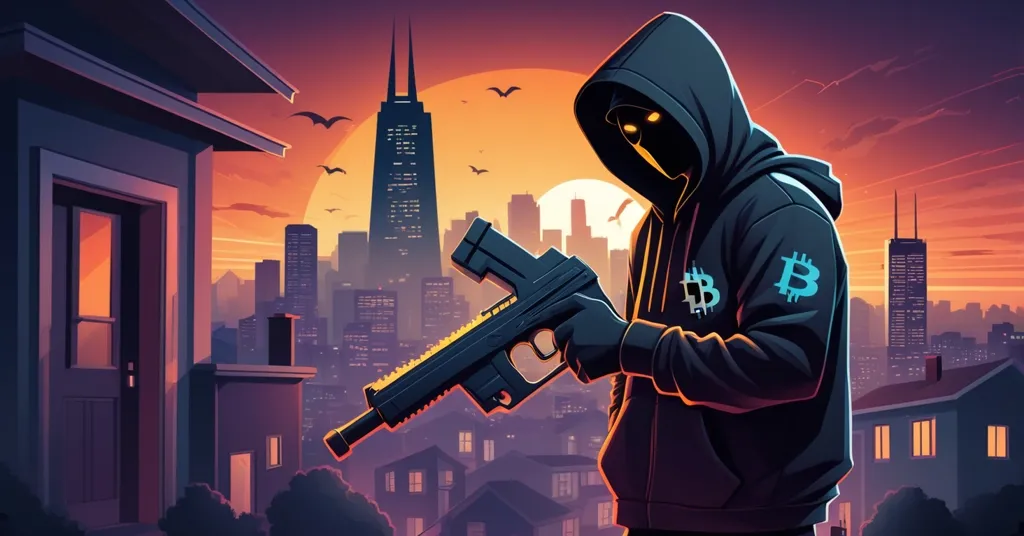San Francisco Crypto Investor Robbed of $11M in Violent Wrench Attack: Safety Wake-Up Call

San Francisco Crypto Investor Loses $11M in Violent Wrench Attack: A Wake-Up Call for Safety
A horrifying robbery in San Francisco has cast a harsh spotlight on the growing dangers facing cryptocurrency investors. On November 22, 2025, a local crypto holder lost approximately $11 million in digital assets during a brutal “wrench attack” by a suspect posing as a delivery driver. This violent home invasion underscores a chilling rise in physical crimes targeting those in the crypto space, raising urgent questions about personal security alongside digital wealth.
- Date and Location: November 22, 2025, Dorland Street, San Francisco.
- Loss: Around $11 million in cryptocurrency, plus a cellphone and laptop.
- Trend: Wrench attacks on crypto investors surged 65% in 2025, with 61 reported cases.
- Implication: Highlights critical need for enhanced personal security among crypto holders.
The San Francisco Robbery: A Calculated Assault
At approximately 6:45 a.m. on that Saturday, the quiet morning was shattered for a resident on the unit block of Dorland Street, near Mission Dolores Park between Dolores and Guerrero streets. A suspect, cloaked in dark clothing, gloves, a hoodie, and sunglasses to obscure their identity, approached the home carrying a white box as a deceptive prop. Posing as a delivery driver, they asked for someone named “Joshua” and requested a signature—a ruse that granted them entry. Once inside, the situation turned deadly serious. The intruder drew a gun, bound the victim with duct tape, and forced access to their cryptocurrency wallet. Alongside the staggering $11 million in digital funds, the thief snatched the victim’s cellphone and laptop. Thankfully, no physical injuries were reported, but the emotional and financial devastation is likely profound. For more details on this shocking incident, see the full report on the San Francisco crypto wrench attack.
The San Francisco Police Department (SFPD) is actively investigating, though no arrests have been made as of now. The case gained traction when Garry Tan, CEO of Y Combinator, posted home security footage on X, urging locals with video from 4:30 to 6:00 p.m. that day to aid law enforcement. His plea carried a raw urgency:
“We have to find the perpetrator. Time is of the essence.” – Garry Tan, Y Combinator CEO
Wrench Attacks on the Rise: A Disturbing Trend
This San Francisco crypto crime isn’t a standalone horror story. It’s part of a broader wave of violence known as wrench attacks—physical assaults where criminals target crypto investors to coerce access to their digital wallets. Data for 2025 shows a staggering 65% increase in these incidents, with 61 reported cases compared to just 38 the year prior. This spike aligns with cryptocurrency’s renewed surge in popularity, as skyrocketing market values attract both genuine enthusiasts and ruthless opportunists. Bitcoin, Ethereum, and other digital assets have become beacons of wealth, but unlike gold stashed in a safe, crypto often hinges on private keys or personal devices that can be forcibly extracted.
Compare this to other recent cases for context. Earlier this year, streaming star Amouranth faced a similar home invasion targeting her crypto holdings, only to be saved by her husband’s quick intervention. In Manhattan, a Bitcoin investor endured a nightmarish kidnapping and torture plot aimed at accessing their stash. Unlike the San Francisco victim, Amouranth avoided loss through sheer luck and preparedness—a stark reminder that physical security can be as critical as a strong password. These incidents signal a shift from the digital scams of yesteryear to in-your-face, gunpoint robberies. The crypto space isn’t just fighting hackers anymore; it’s up against thugs willing to break down doors.
Why Crypto Holders Are Vulnerable: Blockchain’s Double-Edged Sword
One brutal irony fueling this trend is blockchain technology itself. The public ledgers that underpin Bitcoin and many other cryptocurrencies record every transaction for transparency—a feature meant to build trust in a trustless system. But this openness is like pinning your bank balance on a public bulletin board: anyone with the right tools can see how much you’ve got if they know where to look. Criminals use blockchain explorers—free online tools—to track wallet addresses with large holdings. Pair that with a bit of social engineering or doxxing to link a wallet to a real-world identity, and you’ve got a roadmap to a target like our San Francisco victim.
Privacy coins like Monero aim to counter this by obscuring transaction details, but Bitcoin, with its maximalist ethos of transparency over anonymity, remains uniquely exposed. Even Ethereum, with its focus on smart contracts and layer-2 solutions, faces similar traceability issues unless users leverage specific privacy tools. Then there’s operational security, or opsec, which many investors—newbies especially—neglect. Bragging about your Bitcoin gains on social media is like waving a steak at a hungry wolf; don’t be shocked when it bites. Linking real-world identities to wallet addresses or failing to secure private keys offline can turn you into a sitting duck. Face it—crypto has a security problem that no app update can fully fix.
Recovery Challenges: Why Stolen Crypto Is Often Gone Forever
If the personal violation of a wrench attack wasn’t bad enough, the aftermath is often a financial death sentence. Unlike a bank robbery where stolen cash might be traced or accounts frozen, crypto transactions are typically irreversible. Once funds are transferred—often within minutes to anonymous wallets or through mixers that scramble transaction trails—recovering them is like trying to unspool a spiderweb in a storm. In the San Francisco case, even if the SFPD nabs the culprit, there’s little hope of retrieving that $11 million. Blockchain’s design, a bastion of trustless freedom, becomes a cruel trap under coercion.
This differs sharply from digital scams where slow response times or exchange cooperation might offer a lifeline. Wrench attacks are fast, brutal, and final. The speed of on-chain transfers, combined with tools that obscure funds’ destinations, leaves victims and law enforcement scrambling. It’s a harsh lesson: decentralization empowers individuals, but it also means there’s no customer service line to call when a gunman forces your seed phrase out of you.
Law Enforcement Struggles: Outpaced by Crypto Crime
Speaking of law enforcement, the SFPD’s ongoing investigation with no arrests yet reflects a broader challenge. Police forces, even in tech-savvy hubs like San Francisco, often lack the specialized training to tackle crypto-related crimes. Tracking funds through blockchain is a niche skill, and when mixers or cross-border transfers are involved, jurisdictional nightmares kick in. Add to that the anonymity baked into many crypto protocols, and you’ve got a recipe for frustration. Hypothetical 2025 data suggests urban areas like San Francisco report higher wrench attack rates than rural zones, likely due to denser concentrations of wealthy tech investors—yet conviction rates remain dismal across the board.
This isn’t to bash the SFPD or other agencies; it’s to highlight a systemic lag. Traditional crime frameworks aren’t built for digital assets that vanish into the ether. While some advocate for better legal tools or international cooperation, others argue crypto’s very nature resists such oversight—a feature, not a bug, for privacy hawks and decentralization purists. Still, for victims staring at an empty wallet, that ideological win feels hollow.
The Human Cost: Beyond Financial Loss
Let’s not gloss over the psychological toll of these attacks. A home invasion isn’t just a balance sheet hit; it’s a violation of safety that lingers. Studies on trauma from burglaries show victims often grapple with anxiety, insomnia, and distrust long after the event. For the San Francisco investor, losing $11 million in crypto—possibly life savings or generational wealth—compounds that pain. Imagine the gut punch of watching your financial future vanish at gunpoint, knowing recovery is a long shot. Mental health experts note that such sudden, violent loss can mirror the grief of losing a loved one. This isn’t just a crypto problem; it’s a deeply human one.
Playing Devil’s Advocate: Are We Overreacting?
Now, let’s flip the script for a moment. Is the crypto community blowing these wrench attacks out of proportion? Traditional wealth—cash, jewelry, art—has always been a target for physical theft, often with similar violence. Bank robbers didn’t wait for Bitcoin to exist to bust into homes. Could it be that crypto’s unique features, like pseudonymity and borderless value, still outweigh these risks in the long run? Bitcoin maximalists might argue this is a growing pain of a revolutionary system—every paradigm shift has casualties. And they’re not wrong to point out that mainstream adoption was never going to be a cozy stroll. But when you’re duct-taped in your own living room, that big-picture optimism doesn’t stop the shaking.
Protecting Cryptocurrency from Physical Theft: Practical Tips
So, how do you shield yourself from becoming the next San Francisco headline? Wealth in a borderless, pseudonymous system demands a fortress mindset—both digital and physical. Here are actionable steps to boost your security:
- Use Cold Storage: Keep the bulk of your crypto offline on hardware wallets like a Ledger or Trezor—think of it as a USB vault no remote hacker can touch. If a robber demands access, they can’t steal what isn’t online.
- Multi-Signature Wallets: Set up wallets requiring multiple keys to authorize transactions. Spread those keys across secure locations or trusted parties so no single point of failure exists.
- Decoy Wallets: Maintain a small-balance wallet on your phone or laptop for daily use. If forced to hand over access, a thief gets peanuts instead of your real stash.
- Avoid Public Disclosure: Don’t flaunt your holdings on social media or link your identity to wallet addresses. Opsec isn’t paranoia; it’s survival.
- Physical Security: Invest in home defenses—cameras, reinforced doors, even a panic button. If you’re holding millions in crypto, treat your house like a bank.
- Stay Off Public Wi-Fi: Accessing wallets on unsecured networks can leak data to prying eyes. Stick to trusted, encrypted connections.
These aren’t foolproof—nothing is against a determined attacker—but they raise the bar. Education on safety must match the community’s zeal for innovation if we’re serious about driving adoption responsibly.
Balancing Optimism with Reality in the Crypto Revolution
Despite the grim undertones of this San Francisco robbery, the promise of Bitcoin and blockchain tech burns bright. Financial sovereignty, privacy, and a hard shove against centralized control remain ideals worth championing. Bitcoin’s unyielding focus on decentralization is a middle finger to broken systems, while Ethereum and other protocols carve out niches with smart contracts and decentralized apps that Bitcoin doesn’t aim to tackle. This diversity strengthens the ecosystem, even if it’s messy.
Yet, as this wrench attack brutally shows, the path to a decentralized future is littered with real-world hazards no whitepaper can dodge. The community must grapple with these risks head-on—through better opsec, advocacy for tailored legal protections, or simply spreading awareness that your crypto gains aren’t worth your safety. For the San Francisco victim, this incident may ripple through local crypto culture, potentially spurring tighter security norms or even policy debates on digital asset protection. It’s a stark reminder: no bull run justifies a gun to your head.
Key Takeaways and Questions for Reflection
- What is a wrench attack in the crypto world?
A violent physical assault where criminals target crypto holders to force access to digital wallets, often through threats or coercion, as seen in the San Francisco home invasion on November 22, 2025. - Why are physical attacks on crypto investors spiking?
A 65% rise in wrench attacks in 2025 ties to cryptocurrency’s soaring popularity and the ability to trace large holdings via public blockchain data, exposing wealthy investors to thieves. - How tough is recovering funds after a wrench attack?
Incredibly tough—funds are often moved instantly to untraceable wallets, and blockchain’s irreversible nature means recovery is unlikely, even if the thief is caught. - How can crypto holders protect themselves from physical theft?
Use cold storage for assets, multi-signature wallets, and decoy accounts; avoid public disclosure of holdings; and bolster home security with cameras and reinforced entry points. - Can law enforcement keep up with crypto-related crimes?
Challenges persist, as seen in the SFPD’s ongoing probe with no arrests. Limited training, jurisdictional issues, and crypto’s anonymity features often hinder effective responses.
The San Francisco wrench attack isn’t just a crime; it’s a flashing red alert for the crypto community. As we push for a future unshackled from centralized overreach, we must balance that idealism with the gritty work of staying safe in a world still playing catch-up. Keep your keys secure, your address private, and your defenses sharp—because the revolution won’t wait, but neither will the predators.



